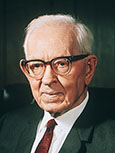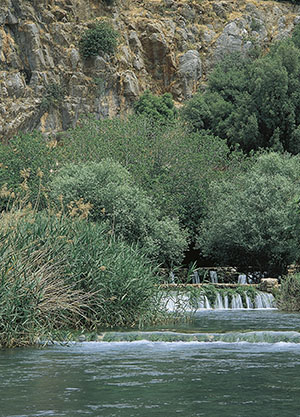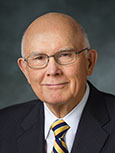Introduction
Jesus Christ rebuked the Pharisees and Sadducees who sought a sign of His divinity. Peter bore testimony that Jesus is the Christ and was promised the keys of the kingdom. Jesus taught His disciples to take up their cross and follow Him.
Suggestions for Teaching
Matthew 16:1–12
The Pharisees and the Sadducees seek a sign from the Savior
Before class, write the following phrases on the board:
Through the appearance of an angel
Through the Holy Ghost
Through believing the words of a friend or familymember
Through witnessing a miracle
To begin the lesson, ask students to choose the phrase on the board that best describes how they would like to receive a testimony of the gospel. Invite a few students to report which phrase they chose and explain why they chose it.
Invite students as they study Matthew 16 to look for truths concerning how the Lord helps us to receive and strengthen our testimonies of the gospel.
Invite a student to read Matthew 16:1 aloud. Ask students to follow along, looking for what the Pharisees and Sadducees wanted from Jesus.
- • What did the Pharisees and Sadducees want from Jesus?
- • What do you think it means that the Pharisees and Sadducees were “tempting” Jesus when they asked for a sign? (One meaning of the verb tempt is to try or to test.)
Invite several students to take turns reading aloud fromMatthew 16:2–4. Ask the class to follow along, looking for the Savior’s response to the Pharisees and Sadducees.
- • What sign did the Lord say He would provide?
Explain that Jesus was referring to the Old Testament prophet Jonah, who had been swallowed by a “great fish” (Jonah 1:17). Jonah’s “burial” in and then coming forth from the belly of the fish after three days symbolized the death, burial, and Resurrection of Jesus Christ from the tomb on the third day.
- • What did the Savior do after He rebuked the Pharisees and Sadducees?
- • What can we learn from this experience about the improper way to seek spiritual truth? (Students may use different words, but make sure they identify the following truth: We do not receive spiritual truth by seeking for signs.)
Summarize Matthew 16:5–12 by explaining that the Savior warned His disciples of the Pharisees’ and Sadducees’ false teachings. (Note: This event will be addressed in greater detail in the lesson on Mark 8.)
Matthew 16:13–20
Peter testifies of Jesus Christ and is promised the keys of the kingdom
Explain that after Jesus rebuked the Pharisees and Sadducees for seeking a sign, He taught His disciples how to receive a testimony of the truth. Invite a student to read Matthew 16:13–14 aloud. Ask the class to follow along, looking for the question Jesus asked and the response His disciples gave.
- • What did the Savior ask His disciples? How did they answer? (You may need to explain that Elias and Jeremias are the Old Testament prophets Elijah and Jeremiah.)
- • What can their response tell us about how well people understood who Jesus was at this point in His ministry?
Invite a student to read Matthew 16:15–17 aloud. Ask the class to follow along, looking for the second question the Savior asked.
- • What was the second question the Savior asked? How did Peter respond?
- • According to verse 17, how did Peter know that Jesus Christ is the Son of God? (Point out that Heavenly Father had revealed this truth to him through the Holy Ghost.)
- • What truth can we learn from these verses about how we can gain a testimony of Jesus Christ? (Students’ answers should reflect the truth that we gain a testimony of Jesus Christ through revelation from the Holy Ghost.)
- • Why do you think it is important for us to receive a testimony through revelation from the Holy Ghost rather than by some other way?
To help students further understand the role of the Holy Ghost in helping us gain a testimony of the Savior, invite a student to read aloud the following statement by President Joseph Fielding Smith:

“The Spirit of God speaking to the spirit of man has power to impart truth with greater effect and understanding than the truth can be imparted by personal contact even with heavenly beings. Through the Holy Ghost the truth is woven into the very fibre and sinews of the body so that it cannot be forgotten” (Teachings of Presidents of the Church: Joseph Fielding Smith [2013], 183–84).
- • What are some things we can do to prepare ourselves to receive revelation through the Holy Ghost?
- • How did you come to know that Jesus Christ is the Son of God and your Savior? What did you do to prepare to receive that witness from the Holy Ghost?
Invite students to ponder their testimonies of the Savior. Encourage them to record in their class notebooks or scripture study journals how they might strengthen their testimonies or what they may need to do to receive a testimony through the Holy Ghost.
Invite two students to come to the front of the classroom and participate in a role play. Assign one student to represent himself or herself and the other student to represent a friend who is not a member of the Church. Give the student representing the nonmember friend a piece of paper containing the two questions below. Invite the student to read the questions aloud one at a time, and ask the other student to reply. (You may want to encourage the class to suggest possible responses the student answering the questions can give.)
- 1. I heard that your church claims to be the only true church of Jesus Christ. Is that what you believe?
- 2. My church also believes in Jesus Christ, so why do you think that your church is the only true one?
Thank the students for participating, and invite them to return to their seats.
Invite students as they continue to study Matthew 16 to look for truths that can help us understand and explain to others what distinguishes The Church of Jesus Christ of Latter-day Saints as the Lord’s Church upon the earth.

Caesarea Philippi
Remind students that when Jesus asked His disciples the questions about His identity, they were in a region called Caesarea Philippi (see Matthew 16:13). If possible, display an image of Caesarea Philippi (seeBible Photographs, no. 26, “Caesarea Philippi”). Ask students to identify what is behind the river and trees in this picture. Explain that the large rock formation at Caesarea Philippi would have provided a meaningful setting as the Savior continued His discussion with His disciples.
Invite a student to read Matthew 16:18–20 aloud. Ask the class to follow along, looking for how the Savior used the concept of a rock to describe the foundation of His Church.
- • What do you think the Savior meant when He said He would build His Church “upon this rock”? (verse 18).
To help students understand this phrase, invite a student to read aloud the following statements by the Prophet Joseph Smith:

“Jesus in His teachings says, ‘Upon this rock I will build my Church. …’ [Matthew 16:18.] What rock? Revelation” (Teachings of Presidents of the Church: Joseph Smith[2007], 195).
- • How would you summarize the Savior’s teaching about His Church recorded in verse 18? (Students should identify something similar to the following principle: Jesus Christ’s Church is built upon revelation from God. Write this truth on the board.)
- • How can knowing that The Church of Jesus Christ of Latter-day Saints is built on revelation from God strengthen your testimony of the gospel?
- • According to verse 19, what did the Savior promise to give Peter?
- • What doctrine can we learn from the promise the Savior gave to Peter? (Make sure students identify the following truth: Jesus Christ entrusts the keys of His kingdom to His chosen prophets and apostles.)
- • What are the keys of the kingdom? (The directing power, right, and authority necessary to preside over the kingdom of God on the earth, or the Church of Jesus Christ.)
To help students understand what priesthood keys are, invite a student to read aloud the following statement by Elder Dallin H. Oaks of the Quorum of the Twelve Apostles:

“‘Priesthood keys are the authority God has given to priesthood [holders] to direct, control, and govern the use of His priesthood on earth’ [Handbook 2: Administering the Church (2010), 2.1.1]. Every act or ordinance performed in the Church is done under the direct or indirect authorization of one holding the keys for that function” (“The Keys and Authority of the Priesthood,” Ensign or Liahona, May 2014, 49).
- • What did Jesus say that Peter would be able to do because of the keys he would be given?
Explain that among the keys the Savior promised to Peter were the keys of the sealing power. This power allows the ordinances performed under the authority of Church leaders to be valid in heaven. It is also used to bind families together for eternity. In our day, the sealing power is held by the First Presidency and the Quorum of the Twelve Apostles.
- • How would you summarize why the Lord gives priesthood keys to His prophets and Apostles? (Students should identify a truth similar to the following: Priesthood keys are necessary to administer the Lord’s Church upon the earth.)
Ask a student to read aloud the questions from the role play. Invite the class to explain how they would respond to these questions using the truths they have identified in Matthew 16:18–19. You may also want to invite students to share their testimonies of these truths.
Consider displaying a picture of the current First Presidency and Quorum of the Twelve Apostles (seeLDS.org [for example, Meet Today’s Prophets and Apostles] and the general conference issues of theEnsign or Liahona) and testifying that the same keys given to Peter and the other Apostles anciently are held and used today by the Lord’s living prophets and Apostles.
Matthew 16:21–28
Jesus teaches what it means to follow Him
Summarize Matthew 16:21–28 by explaining that Jesus spoke of His atoning sacrifice. He also taught His disciples that they must be willing to deny the natural man (see Mosiah 3:19), be obedient, and sacrifice in order to cheerfully follow Him.
 Scripture Mastery—Matthew 16:15–19
Scripture Mastery—Matthew 16:15–19
Encourage students to share with their families what they learned from Matthew 16. Consider choosing a portion of Matthew 16:15–19 to memorize as a class during the coming days. You can find ideas for memorization in the appendix of this manual.
Commentary and Background Information
Matthew 16:1–4. The Pharisees and Sadducees seek a sign
Matthew 16:1–4 relates an exchange between Jesus Christ and some sign-seeking Pharisees and Sadducees, who came “tempting” the Savior to show them a sign (verse 1). (One meaning of the verb tempt is to try or to test.) In response to their request, Jesus rebuked them for being proud of their ability to recognize the signs of changing weather but failing to recognize God’s signs (see verses 2–3). The Savior also taught that “a wicked and adulterous generation seeketh after a sign” (verse 4). When individuals persist in serious sin, one consequence is that they no longer recognize the quiet and gentle whisperings of the Spirit and they demand proof in the form of physical, tangible, or sensational signs.
Matthew 16:4. “The sign of the prophet Jonas”
Elder Bruce R. McConkie of the Quorum of the Twelve Apostles explained the sign of the prophet Jonas:
“Jonah’s burial in and coming forth from the ‘great fish’ (Jonah 1:15–17; 2) symbolizes the death, burial, and resurrection of Christ” (Mormon Doctrine, 2nd ed. [1966], 711–12).
Matthew 16:18. “Upon this rock I will build my church”
“As the Savior taught Peter about revelation, He used a wordplay on Peter’s name, declaring to Simon [Peter], ‘Thou art Peter[Petros], and upon this rock [petra] I will build my church’ (Matthew 16:18). The Greek word petros means an isolated small rock or stone. The Greek word petra can also mean ‘a stone,’ but in addition it can refer to stony soil, bedrock, or a large mass of rock. From these words we learn that it was not upon Peter as a man that the Church would be built, but upon the bedrock of revelation” (New Testament Student Manual [Church Educational System manual, 2014], 53).
Matthew 16:18–19. “The keys of the kingdom”
President Russell M. Nelson of the Quorum of the Twelve Apostles explained how the Lord continues to lead His Church and kingdom on the earth through prophets and sacred priesthood keys:
“The living Lord leads His living Church [see D&C 1:30, 38]! The Lord reveals His will for the Church to His prophet. Yesterday, after we were invited to sustain Thomas S. Monson as President of the Church, we also had the privilege to sustain him, the counselors in the First Presidency, and members of the Quorum of the Twelve Apostles as prophets, seers, and revelators. Think of that! We sustain 15 men as prophets of God! They hold all the priesthood keys that have ever been conferred upon man in this dispensation. …
“[President Gordon B. Hinckley explained,] ‘The First Presidency and the Council of the Twelve Apostles, called and ordained to hold the keys of the priesthood, have the authority and responsibility to govern the Church, to administer its ordinances, to expound its doctrine, and to establish and maintain its practices’ [“God Is at the Helm,” Ensign, May 1994, 54]” (“Sustaining the Prophets,” Ensign or Liahona, Nov. 2014, 75–76).
Matthew 16:21–23. Jesus Christ rebukes Peter
“By focusing only on the Savior’s coming death, Peter failed to understand Jesus Christ’s true mission—the redemption of all mankind. When the Savior rebuked Peter and referred to him as ‘Satan’ [Matthew 16:23; Mark 8:33], He was not implying that Peter was Lucifer. The Hebrew word satan means ‘adversary or tempter.’ Thus, Christ recognized that at that moment Peter had put himself in an adversarial role, in opposition to the Savior’s ultimate saving mission.
“Peter probably meant well when he objected to the teaching that Jesus Christ would have to suffer and be killed (see Matthew 16:22; Mark 8:32). However, if Jesus had accommodated Peter’s wishes by avoiding the suffering of the Atonement, there would have been no redemption from sins and no Resurrection conquering death. All mankind would unavoidably have perished (see Alma 34:9), and God’s work of bringing to pass ‘theimmortality and eternal life of man’ (Moses 1:39) would not have been fulfilled. All this would have served the destructive aims of Satan. In the moment of his impulsive protest, Peter was unwittingly siding with the adversary” (New Testament Student Manual [Church Educational System manual, 2014], 122).
Supplemental Teaching Idea
Matthew 16:24–28. “Take up his cross, and follow me”
Write the following incomplete statement on the board: To follow Jesus Christ, we must …
Invite a few students to take turns reading aloud from Matthew 16:24–28. Ask the class to follow along, looking for counsel the Savior gave to those who seek to follow Him.
- • What counsel did the Savior give to those who seek to follow Him?
Invite a student to read the following statement aloud:
“Even before the Savior’s Crucifixion, the image of ‘taking up one’s cross’ (see Mark 8:34) would have been a familiar and perhaps troubling one for the disciples. Crucifixion was a common means of execution in the Roman Empire, and its victims were made to carry their own crossbeams to the place of execution (see John 19:16–17). By using this imagery, the Savior vividly taught His disciples what they must be ready for and called upon them to follow His example by submitting to the will of the Father in their lives” (New Testament Student Manual[Church Educational System manual, 2014], 122).
Invite a student to read Matthew 16:24, footnote e, aloud. Ask the class to follow along, looking for how the Joseph SmithTranslation of this verse helps us further understand what it means to take up our cross.
- • Based on the Joseph Smith Translation of this verse, how would you complete the statement on the board? (After students respond, use their words to complete the statement so it reads something like the following: To follow Jesus Christ, we must deny ourselves of all ungodliness and every worldly lust and keep His commandments.)
Explain that the word ungodliness refers to anything that is evil or unworthy and would prevent us from becoming like Heavenly Father and Jesus Christ.
- • What are some ways we can seek to deny ourselves of all “ungodliness” and “worldly lusts”?
沒有留言:
張貼留言